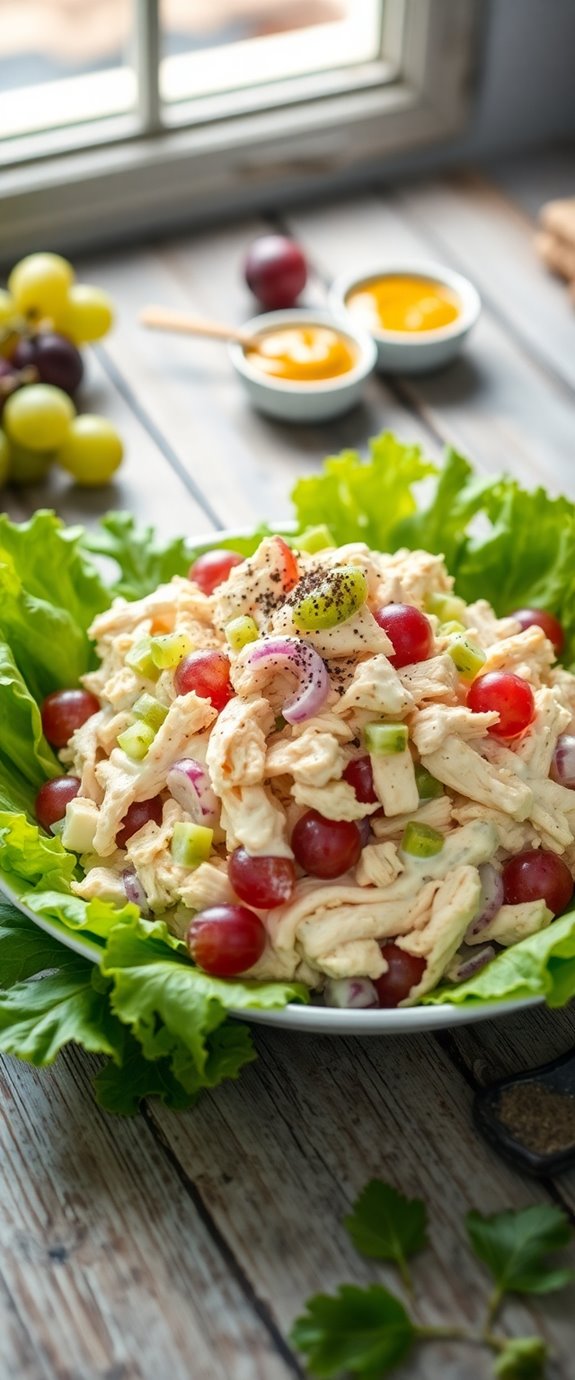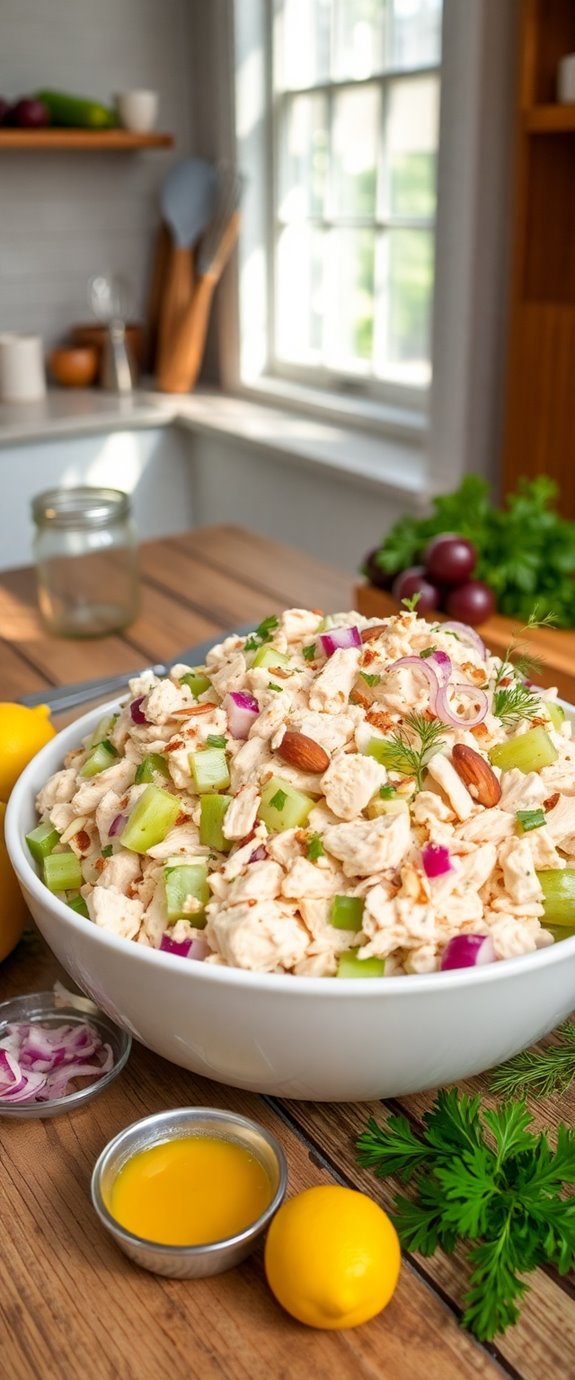When you're looking for a healthy meal option that doesn't compromise on flavor, a Low Sodium Chicken Salad can be a game changer. You can easily whip up this nutritious dish by combining cooked chicken with fresh vegetables and a light dressing, all while keeping the sodium content in check. It's versatile enough for lunches, wraps, or even as a snack. However, if you're wondering how to elevate this basic recipe or what substitutions might enhance it further, keep exploring the possibilities.
Recipe Tips and Tricks
- Combine 2 cups cooked, shredded skinless chicken breast with 1 cup each of diced celery, bell peppers, and red onion in a large bowl.
- Whisk together ½ cup plain Greek yogurt, 2 tbsp lemon juice, and 1 tsp dried dill to create a light dressing.
- Pour the dressing over the chicken and vegetable mixture, then toss gently until well coated.
- Serve the chicken salad on fresh lettuce leaves or use as filling for sandwiches or wraps.
- Customize with nuts, seeds, or additional vegetables for enhanced flavor and nutrition while keeping it low sodium.
How To Make It – Recipe

Making a delicious low sodium chicken salad is a fantastic way to enjoy a healthy meal without compromising on flavor. This dish isn't only easy to prepare but also versatile, allowing you to customize it with your favorite ingredients while keeping the sodium content low. By using fresh vegetables, lean chicken, and a light dressing, you can create a satisfying and nutritious salad that's perfect for lunch, dinner, or even as a snack.
To start, you'll need cooked chicken breast, which you can grill, bake, or poach. Using skinless chicken breast helps reduce the fat content, making this dish even healthier. Pair it with a mix of colorful vegetables like bell peppers, celery, and red onions for added crunch and nutrients.
To keep the flavors bright, a simple dressing made from Greek yogurt, lemon juice, and herbs will enhance the overall taste while keeping it low in sodium. Additionally, you can incorporate dairy-free options to make your salad even more inclusive for those with dietary restrictions.
Ingredients:
- 2 cups cooked, shredded chicken breast
- 1 cup diced celery
- 1 cup diced bell peppers (any color)
- 1 cup diced red onion
- 1/2 cup plain Greek yogurt
- 2 tablespoons lemon juice
- 1 teaspoon dried dill
- 1/2 teaspoon black pepper
- 1/4 teaspoon garlic powder
- 1/4 teaspoon onion powder
- Fresh lettuce leaves (for serving)
In a large mixing bowl, combine the shredded chicken, diced celery, diced bell peppers, and diced red onion. In a separate bowl, whisk together the Greek yogurt, lemon juice, dill, black pepper, garlic powder, and onion powder until smooth.
Pour the dressing over the chicken and vegetable mixture, and toss gently until everything is evenly coated. Serve the chicken salad on a bed of fresh lettuce leaves or use it as a filling for a sandwich or wrap.
When making this low sodium chicken salad, feel free to experiment with other ingredients like diced apples, grapes, or nuts for added texture and flavor. If you prefer a creamier texture, you can adjust the amount of Greek yogurt to your liking or even try adding a small amount of avocado.
Remember to taste and adjust the seasoning to your preference, ensuring that you keep the sodium levels in check while maximizing flavor!
Substitution Suggestions
If you want to customize your low sodium chicken salad further, consider some substitution options that can enhance flavor and texture without adding excess sodium.
Start by exploring herb alternatives like fresh dill, basil, or cilantro. These herbs not only elevate the taste but also provide essential nutrients, making your salad more vibrant and healthful.
For a bit of zest, try incorporating lemon juice or vinegar as flavor enhancers. They can brighten the dish and create a revitalizing balance without increasing sodium levels.
If you're looking for a creamier texture, consider using plain Greek yogurt instead of mayonnaise. It offers a rich consistency while adding protein, and you can flavor it with herbs or spices to keep it exciting.
You might also think about adding nuts or seeds, like walnuts or sunflower seeds, for crunch and healthy fats. Just be mindful of portion sizes, as they can add calories.
Finally, don't hesitate to experiment with different vegetables like cucumbers, bell peppers, or avocados, which can further enhance the salad's texture and nutritional value. Including avocado chicken salad can also introduce a deliciously creamy element to your dish.
Enjoy your creative cooking!
Serving Suggestions
To elevate your low sodium chicken salad experience, consider how you serve it, as presentation can greatly enhance enjoyment. Serving it on whole-grain bread, lettuce wraps, or even in a pita can create delicious sandwich options that appeal to different tastes and preferences. Each option adds its own texture and flavor, making your meal more satisfying.
For a fresh, nutritious twist, pair your chicken salad with a colorful array of vegetables. Crunchy cucumbers, sweet bell peppers, or crisp celery sticks make excellent companions. You can also serve your salad atop a bed of mixed greens, which adds volume and nutrients without notably increasing sodium levels.
If you're hosting a gathering, consider serving your chicken salad in bite-sized portions, like on cucumber rounds or in mini cups, to encourage mingling. Including healthy ingredients can also enhance the overall nutrition of your dish.
You might even create a buffet-style setup, allowing guests to customize their salad with various toppings—think avocado slices, cherry tomatoes, or nuts. This way, you not only enhance the flavor profile but also engage your guests in a fun, interactive dining experience.
Make-Ahead and Storage
While preparing meals in advance can save you time during busy weekdays, knowing how to properly store your low sodium chicken salad is essential for maintaining its freshness and flavor.
When you make this chicken salad as part of your meal prep, consider portioning it into airtight containers. This not only keeps the salad fresh but also makes it easy to grab a healthy snack when you're on the go.
It's best to store your salad in the refrigerator, where it can last up to three to four days. To retain the best texture, avoid adding any ingredients that may become soggy over time, like certain vegetables, until you're ready to serve.
If you plan to enjoy your chicken salad as a meal prep option throughout the week, consider separating the dressing and mixing it in right before eating. Additionally, using low carb options can enhance the nutritional value of your salad while keeping it flavorful.
You can also freeze portions of your low sodium chicken salad for longer storage, but keep in mind that certain ingredients mightn't defrost well.
Always label your containers with dates to keep track of freshness. With these storage tips, you can enjoy your delicious chicken salad as a convenient and nutritious option whenever you need it.
How to Store and Reheat Leftovers
Since you want to enjoy your low sodium chicken salad later, proper storage and reheating methods are essential.
Start by transferring any leftovers into an airtight container. This minimizes exposure to air, helping to preserve freshness and prevent spoilage. It's best to refrigerate your salad within two hours of preparation to guarantee food safety. Generally, it'll stay good for about three to four days in the fridge.
When it comes to reheating, you'll want to handle your chicken salad with care. Since it contains ingredients like mayonnaise or yogurt, which don't fare well in high heat, it's best to eat it cold. Additionally, you can enhance the flavor by adding fresh herbs or spices before enjoying your meal, making it deliciously healthy(#) even after storage.
If you prefer it warm, consider heating only the chicken separately and then mixing it back into the salad once it's cooled slightly.
For best results, avoid repeated reheating, as this can affect the texture and flavor. Instead, portion out what you plan to eat, which makes for easy leftover storage and helps you maintain the quality of the salad.
Always check for any off smells or changes in texture before consuming leftovers, guaranteeing your meal stays both safe and delicious.
Nutrition Facts(per serving)
Understanding the nutrition facts of your low sodium chicken salad can help you make informed choices about your meal. Each serving typically contains around 250 calories, making it a light yet satisfying option. The caloric content comes primarily from the chicken and any additional ingredients like yogurt or avocado, which contribute healthy fats.
One of the standout features of this salad is its high protein content. With about 30 grams of protein per serving, your chicken serves as an excellent protein source, essential for muscle repair and overall health. If you add nuts or seeds, you'll not only increase the protein but also benefit from healthy fats and fiber.
Moreover, this salad is low in sodium, usually containing less than 200 milligrams per serving. This makes it a heart-healthy choice, especially for those monitoring their salt intake. Additionally, incorporating light ingredients can enhance the overall nutritional profile and flavor of your salad.
Final Thoughts
When you choose to make a low sodium chicken salad, you're not just opting for a meal; you're making a conscious decision to prioritize your health. This dish not only supports your dietary needs but also encourages healthy eating habits. By using fresh ingredients and controlling sodium content, you can enjoy a flavorful salad that aligns with your wellness goals.
Incorporating low sodium chicken salad into your meal prep can simplify your week while ensuring you're consuming nutritious options. Prepare a larger batch to store in the fridge, making it easy to grab a healthy lunch or snack on busy days. This approach saves time and helps you resist the temptation of higher sodium convenience foods.
Moreover, you can customize the salad with various vegetables, herbs, and spices, enhancing both flavor and nutritional value. Remember, healthy eating is about balance and making choices that benefit your body. Additionally, using lean protein like chicken in your salad can help maintain a lower calorie intake while still providing essential nutrients.
Ultimately, a low sodium chicken salad is a smart and delicious choice that supports your health while fitting seamlessly into your meal prep routine. Embrace this recipe as a step towards a healthier lifestyle, and enjoy the journey of nourishing your body with every bite.
Recipe FAQs
Can I Use Canned Chicken for This Low Sodium Salad?
Yes, you can use canned chicken for your salad. Just check the sodium content on the label, as some brands can be high in sodium. Opt for low-sodium varieties to keep your dish healthier.
What Is a Good Low Sodium Dressing Alternative?
For a good low sodium dressing alternative, consider using Greek yogurt for a creamy texture or whip up a homemade vinaigrette with olive oil, vinegar, and herbs. Both options enhance flavors without excessive salt.
How Can I Add More Protein to the Salad?
To boost protein in your salad, try mixing in Greek yogurt or cottage cheese. Both options add creaminess while increasing protein content, making your dish more satisfying and nutritious without compromising flavor or texture.
Is This Chicken Salad Suitable for Meal Prep?
Yes, this chicken salad's perfect for meal prep! Use airtight meal prep containers for storage. Keep it refrigerated, and follow storage tips to maintain freshness for up to three days without compromising flavor or texture.
What Vegetables Pair Well With Low Sodium Chicken Salad?
You'll find crunchy vegetables like celery and bell peppers enhance your dish, while fresh herbs such as parsley or dill add vibrant flavor. These combinations not only boost taste but also improve nutritional value considerably.







